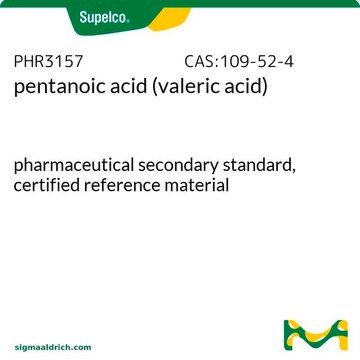75054
Valeric acid
analytical standard
Sinónimos:
n-Valeric acid, Pentanoic acid
About This Item
Productos recomendados
grado
analytical standard
Nivel de calidad
densidad de vapor
3.5 (vs air)
presión de vapor
0.15 mmHg ( 20 °C)
Análisis
≥99.8% (GC)
temp. de autoignición
707 °F
caducidad
limited shelf life, expiry date on the label
lim. expl.
7.6 %
técnicas
HPLC: suitable
gas chromatography (GC): suitable
índice de refracción
n20/D 1.408 (lit.)
n20/D 1.408
bp
110-111 °C/10 mmHg (lit.)
185 °C (lit.)
mp
−20-−18 °C (lit.)
densidad
0.939 g/mL at 25 °C (lit.)
aplicaciones
cleaning products
cosmetics
flavors and fragrances
food and beverages
personal care
formato
neat
cadena SMILES
CCCCC(O)=O
InChI
1S/C5H10O2/c1-2-3-4-5(6)7/h2-4H2,1H3,(H,6,7)
Clave InChI
NQPDZGIKBAWPEJ-UHFFFAOYSA-N
¿Está buscando productos similares? Visita Guía de comparación de productos
Categorías relacionadas
Descripción general
Aplicación
Palabra de señalización
Danger
Frases de peligro
Consejos de prudencia
Clasificaciones de peligro
Aquatic Chronic 3 - Eye Dam. 1 - Skin Corr. 1B
Código de clase de almacenamiento
8A - Combustible corrosive hazardous materials
Clase de riesgo para el agua (WGK)
WGK 1
Punto de inflamabilidad (°F)
192.2 °F - closed cup
Punto de inflamabilidad (°C)
89 °C - closed cup
Equipo de protección personal
Faceshields, Gloves, Goggles, type ABEK (EN14387) respirator filter
Choose from one of the most recent versions:
¿Ya tiene este producto?
Encuentre la documentación para los productos que ha comprado recientemente en la Biblioteca de documentos.
Los clientes también vieron
Nuestro equipo de científicos tiene experiencia en todas las áreas de investigación: Ciencias de la vida, Ciencia de los materiales, Síntesis química, Cromatografía, Analítica y muchas otras.
Póngase en contacto con el Servicio técnico










